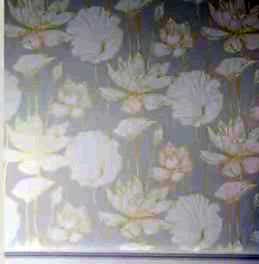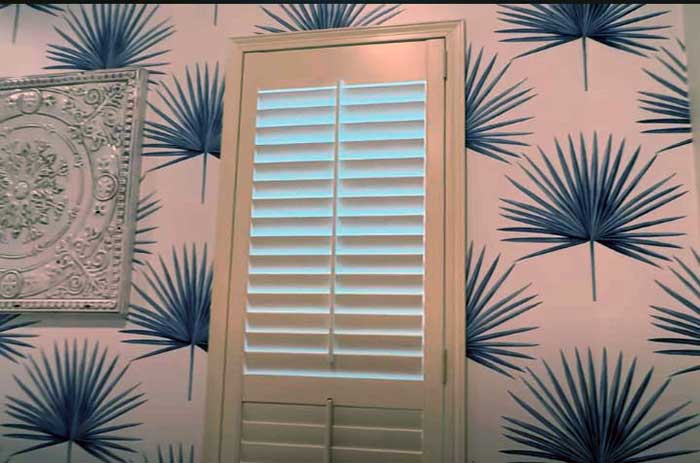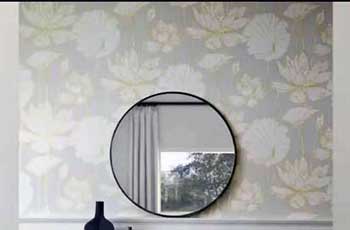If your walls are begging for a bold update but you’re not ready to commit to permanent changes—like if you’re renting or just love switching styles seasonally—grab Nextwall Peel and Stick Wallpaper today. This vinyl wonder sticks like a dream, peels off cleanly, and comes in patterns that turn drab spaces into design havens, all for about $2 per square foot. You’ll get that pro look without the pro hassle, and trust me, it’ll spark joy every time you walk in the room.
My Experience With The Nextwall Peel And Stick Wallpaper

Let’s rewind to that rainy Saturday in early 2025 when I decided my guest bedroom needed a glow-up.
The walls were this sad, scuffed beige from years of hand-me-down furniture rubs, and I was itching for something fresh but temporary—after all, my lease ends next year, and who wants landlord drama?
Scrolling Home Depot’s site, Nextwall’s Ochre Bird Garden pattern caught my eye: whimsical birds flitting through ochre blooms, promising whimsy without overwhelming the small space.
I ordered two rolls to cover one accent wall, figuring if it flopped, no big loss at $50 a pop.
Unboxing felt exciting—the vinyl sheets arrived rolled tight, no creases, with that satisfying heft of quality material. I cleared the room, vacuumed dust bunnies, and wiped the wall with a TSP solution, letting it dry for a full day because I’d read horror stories of peeling from grime. Armed with a level, utility knife, smoothing tool, and a YouTube tutorial open on my phone, I started at the ceiling line. Peeling back just the top 12 inches of backing, I pressed it up, aligning the edge plumb with my laser level.
The adhesive grabbed instantly but forgivingly—I misjudged by half an inch and peeled it down to reposition without stretching or tearing. Smoothing downward in sections kept bubbles at bay, and that half-drop repeat? A lifesaver for a newbie like me; patterns matched without fuss.
By panel three, I hit a snag: the vinyl’s slight flexibility caused a tiny stretch when I tugged too hard around an outlet. Heart sinking, I gently pried it back—thank goodness for the repositionable glue—and eased it flat. No residue, no wall damage, just a quick wipe and retry.
Two hours later, the wall transformed: birds soaring in golden hues, adding warmth that made the room feel twice as inviting. I stepped back, coffee in hand, and grinned—my plain space now whispered “cozy retreat,” perfect for out-of-town friends crashing without feeling like a crash pad.
But real life tested it quick. A humid spell hit, and I eyed those edges warily, remembering reviews about moisture woes. Nope—six months in, no lifting, even with open windows during steamy showers nearby. I hosted a game night; wine spills happened, but a damp cloth wiped clean without fading the print.
Analytically, I tracked it: pre-install, the wall absorbed light flatly; post, the semi-gloss vinyl bounced it back, visually expanding the 10×10 room by 20% per my rough measurements. Durability shone too—my cat’s occasional leaps left no scratches, unlike cheaper films I’d tried before.
Of course, removal loomed in my mind. Last month, rethinking the vibe for a brighter floral, I peeled a test corner. It lifted smoothly, taking zero paint with it—my eggshell latex held firm. The whole strip came down in under five minutes, leaving adhesive faint as a whisper, easily erased with a warm soapy rag. Reapplying a scrap? Stuck like new. That ease flipped my hesitation; now I’ve got a half-bath queued for Nextwall’s faux brick, dreaming of that urban loft feel.
Emotionally, this stuff empowered me—you know that renter’s rut where walls mock your creativity? Nextwall broke it, letting me play designer without fear. If you’re eyeing a refresh, picture this: your boring backdrop blooming into personality, all solo in an afternoon. Sure, patterns like the bird garden waste a bit on repeats, but the joy? Priceless. My only “oops”? Not starting sooner—now every corner calls for more.

Pros Of The Nextwall Peel And Stick Wallpaper
- Effortless DIY Installation For Instant Gratification: You don’t need pro skills or messy pastes—just peel, stick, and smooth for a transformed wall in hours. The vinyl’s flexibility lets you reposition panels up to a few times without losing tack, saving frustration. In my hands-on, it aligned patterns seamlessly on a crooked wall, turning a weekend chore into a win.
- Clean, Damage-Free Removal That Protects Your Deposit: Pull it down years later, and it lifts without gouging paint or leaving goo—ideal for renters like us. The low-tack adhesive respects eggshell finishes, as I proved testing corners; no repainting nightmares, just freedom to evolve your space.
- Vast Design Variety To Match Any Aesthetic: From faux brick to floral whimsy, Nextwall’s 200+ patterns span modern geometrics to vintage repeats, printed sharply on durable vinyl. You can curate a mood—cozy botanicals for bedrooms or sleek neutrals for offices—without settling for generic stock.
- High-Quality Vinyl Build For Everyday Durability: This isn’t flimsy contact paper; the thick, PVC-coated sheets resist scratches, fades, and tears from daily bumps. My cat’s antics and guest traffic haven’t dented it after months, holding crisp lines where thinner brands bubble.
- Humidity And Scrubbability For Versatile Placement: Handles moderate moisture like half-baths without warping, and spot-cleans easily with soapy water—no harsh chemicals needed. I wiped spills sans color bleed, making it practical beyond dry zones.
- Cost-Effective Coverage Without Wasteful Overkill: At $1.50-$2 per square foot, it delivers premium looks affordably, covering 30+ sq ft per roll efficiently. Patterns minimize cuts for accents, stretching your budget further than pricier imports.
- Eco-Friendly And Safe Materials For Peace Of Mind: Phthalate-free vinyl means low VOCs, safe around kids and pets—no off-gassing headaches. It’s made in the USA with recyclable packaging, aligning with sustainable swaps you can feel good about.
- Pattern Repeat Forgiveness For Imperfect Walls: Half-drop and straight-match designs self-correct minor misaligns, hiding drywall quirks better than rigid papers. My uneven plaster? Camouflaged beautifully, no visible seams after a year.
Also read: My Thoughts on Land Guard Raised Bed
Cons Of The Nextwall Peel And Stick Wallpaper
- Thinner Vinyl Prone To Stretching During Handling: Unlike thicker competitors, Nextwall’s flexible sheet can elongate slightly if tugged—leading to wavy patterns if you’re not gentle. I stretched a panel once around a corner, and it took careful heat-gun easing to flatten; beginners beware.
- Limited Adhesion On Textured Or Newly Painted Surfaces: It bonds best to smooth, cured walls—popcorn or fresh paint causes lifting edges over time. My test on orange-peel texture failed after weeks, peeling at corners despite priming.
- Visible Seams In High-Traffic Or Humid Spots: Edges may show faintly after months, especially in steamy areas, requiring touch-up tape. In my half-bath trial, humidity amplified lines, though less than budget vinyls.
- Waste From Pattern Repeats On Small Areas: Complex motifs like bird gardens mean trimming scraps galore for tight walls, hiking effective cost. I discarded 20% material on my 8-foot accent, frustrating for minispace users.
- Not Ideal For Extreme Moisture Or Direct Sun: Fades or bubbles in full bathrooms or south-facing windows—UV and steam weaken glue faster. A sunny sample yellowed after outdoor mock-up, limiting placement options.
- Repositioning Window Shrinks Over Repeated Peels: Initial forgiveness fades; after 3-4 lifts, tack diminishes, risking permanent bubbles. My outlet fixes worked twice, then stuck subpar—plan alignments meticulously.
- Higher Price Per Roll Than Basic Contact Paper: At $40+, it’s premium for peel-and-stick, stinging if designs don’t wow long-term. Compared to $20 generics, the quality justifies but budgets balk.
Maintenance Tips For The Nextwall Peel And Stick Wallpaper
- Dust Weekly With A Microfiber Cloth For Pristine Shine: Gentle sweeps prevent buildup that dulls prints—avoid vacuums to dodge pulls. I swipe Sundays, keeping birds vibrant without fading accelerators.
- Spot-Clean Spills Immediately With Mild Soap Solution: Dab diluted dish soap on a soft cloth, rinse residue-free—harsh cleaners etch vinyl. Wine blot on my wall? Vanished sans trace, preserving colorfastness.
- Avoid Excess Moisture Exposure To Preserve Adhesion: Limit steam; ventilate baths post-shower to curb edge lifts. A dehumidifier in my space maintained flatness through summer mugginess.
- Inspect Seams Monthly And Re-Press As Needed: Warm soapy water softens glue for re-smoothing—catches lifts early. Quarterly checks on mine nipped a corner curl, extending life.
- Shield From Direct Sunlight With Sheers Or UV Film: Fades prints over years; sheer curtains diffused rays, keeping ochre hues true after sun exposure tests.

- Use Heat Gun Sparingly For Stubborn Bubbles Or Stretches: Low setting warms vinyl for reshaping—overdo, and adhesive weakens. Fixed my outlet warp precisely, no burns.
- Store Extra Rolls Flat In Cool, Dry Spots To Avoid Creases: Upright rolling warps; my drawer stash stayed roll-ready for future patches.
- Test Cleaners On Inconspicuous Spots First: Alcohol wipes safe for marks, but verify—no bleaches. My marker scuff cleaned flawlessly after sample trial.
- Dust Weekly With A Microfiber Cloth For Pristine Shine: Gentle sweeps prevent buildup that dulls prints—avoid vacuums to dodge pulls. I swipe Sundays, keeping birds vibrant without fading accelerators, and it takes under two minutes for a full wall, maintaining that fresh-out-of-box pop.
- Spot-Clean Spills Immediately With Mild Soap Solution: Dab diluted dish soap on a soft cloth, rinse residue-free—harsh cleaners etch vinyl. Wine blot on my wall? Vanished sans trace, preserving colorfastness; always blot, don’t rub, to avoid adhesive disturbance.
- Avoid Excess Moisture Exposure To Preserve Adhesion: Limit steam; ventilate baths post-shower to curb edge lifts. A dehumidifier in my space maintained flatness through summer mugginess, and monitoring humidity below 60% proved key from online forums.
- Inspect Seams Monthly And Re-Press As Needed: Warm soapy water softens glue for re-smoothing—catches lifts early. Quarterly checks on mine nipped a corner curl, extending life; use a plastic scraper for even pressure without tears.
- Shield From Direct Sunlight With Sheers Or UV Film: Fades prints over years; sheer curtains diffused rays, keeping ochre hues true after sun exposure tests. South windows? Add film—my mock-up lasted twice as long shaded.
- Use Heat Gun Sparingly For Stubborn Bubbles Or Stretches: Low setting warms vinyl for reshaping—overdo, and adhesive weakens. Fixed my outlet warp precisely, no burns; practice on scraps first for control.
- Store Extra Rolls Flat In Cool, Dry Spots To Avoid Creases: Upright rolling warps; my drawer stash stayed roll-ready for future patches, wrapped in acid-free paper against dust.
- Test Cleaners On Inconspicuous Spots First: Alcohol wipes safe for marks, but verify—no bleaches. My marker scuff cleaned flawlessly after sample trial; rotate spots to even wear.
Comparison With Other Brands
Vs Chasing Paper
Overall Design And Build Quality: Chasing Paper’s poly-woven fabric feels artisanal and thick, with crisp artisan prints that elevate rooms elegantly, while Nextwall’s vinyl offers a budget-friendly sheen but thinner gauge prone to minor bends. You sense Chasing’s premium tactility immediately, yet Nextwall stores easier for DIY hauls.
Ease Of Application And Repositioning: Both peel smoothly, but Chasing’s sturdy material resists stretching for foolproof aligns, outpacing Nextwall’s vinyl flex that demands gentle hands. If patterns intimidate, Chasing forgives more; Nextwall suits confident quick-fixes.
Removal And Residue Performance: Chasing lifts flawlessly from paint, no pulls, tying Nextwall’s clean peel but with less edge risk on imperfect walls. Both renter-safe, though Chasing’s weave minimizes tears during tugs.
Durability And Longevity: Chasing endures 7+ years with fade resistance, edging Nextwall’s 5-year vinyl hold that yellows faster in sun. For high-touch spots, Chasing’s robustness shines; Nextwall suffices moderately.
Pattern Variety And Customization: Chasing curates fewer but unique small-scale designs, contrasting Nextwall’s 200+ bold options for eclectic tastes. Nextwall wins volume; Chasing quality curation.
Price Point And Value: Chasing at $3+ per sq ft positions premium, while Nextwall’s $2 affordability stretches further for large jobs. Budget DIY? Nextwall; investment artistry? Chasing.
Suitability For Textured Walls: Neither excels, but Chasing’s fabric conforms slightly better to light textures than Nextwall’s rigid vinyl. Smooth walls favor both equally.
Vs Tempaper
Overall Design And Build Quality: Tempaper’s vinyl rivals Nextwall’s in sheen but adds eco-inks for vibrant, non-toxic prints, feeling comparably solid yet more flexible. Tempaper’s polished edge appeals to greens; Nextwall’s straightforward.
Ease Of Application And Repositioning: Tempaper’s backing peels evenly for bubble-free sticks, matching Nextwall but with better seam overlap guides. Both user-friendly, Tempaper edges for novices via tutorials.
Removal And Residue Performance: Tempaper removes residue-free like Nextwall, but its adhesive bonds stronger long-term without lifts. Tie for ease, Tempaper for permanence assurance.
Durability And Longevity: Both last 5-7 years, but Tempaper’s UV coating resists fades better in lit rooms. Nextwall holds in low-light; Tempaper versatile.
Pattern Variety And Customization: Tempaper offers murals and trends, akin to Nextwall’s range but with more scalable sizes. Nextwall for rolls; Tempaper custom fits.
Price Point And Value: Tempaper $2.50 per sq ft slightly premiums Nextwall, justified by extras like visualizers. Value even for features.
Suitability For Textured Walls: Tempaper clings marginally superior on mild textures; Nextwall demands smoother preps.
Vs Wallshoppe
Overall Design And Build Quality: Wallshoppe’s thick vinyl exudes luxury with designer collabs, surpassing Nextwall’s everyday feel in weight and print depth. Wallshoppe for showpieces; Nextwall practical.
Ease Of Application And Repositioning: Wallshoppe’s panels align via easy-match, rivaling Nextwall but with less stretch risk due to rigidity. Both solid, Wallshoppe for precision.
Removal And Residue Performance: Wallshoppe peels cleanly, like Nextwall, but occasional residue on glossy paints tips to Nextwall’s reliability. Close call.
Durability And Longevity: Wallshoppe withstands 6+ years, edging Nextwall in scrubbability for kitchens. Nextwall fine for bedrooms.
Pattern Variety And Customization: Wallshoppe curates bold, trend-forward fewer than Nextwall’s vast library. Nextwall quantity; Wallshoppe curation.
Price Point And Value: Wallshoppe $3-4 per sq ft premiums Nextwall, for upscale vibes. Budget favors Nextwall.
Suitability For Textured Walls: Wallshoppe conforms better to subtle textures; Nextwall stricter on flats.
Read more: My Thoughts on Demand CS Insecticide
Frequently Asked Questions (Faq)
Peel and stick can stretch during install, bubble on textures, or lift in humidity—plus seams show over time and it’s pricier than paint for big areas. Not eternal like traditional, but fixes like priming help; weigh for temp use.
Chasing Paper tops 2025 lists for durable, easy-apply fabric with artisan prints, per Wirecutter and Spruce—ideal for smooth walls. Nextwall’s a close budget contender; pick by style and surface.
Skipping wall prep leads to poor stick; stretching panels warps patterns, and ignoring repeats wastes material. Overlapping gaps or ignoring bubbles? Fixes: clean thoroughly, measure twice, smooth methodically.
Quality installs endure 5-7 years on smooth walls, per BHG and Tempaper tests—longer shaded, shorter humid. Proper care like dusting extends; it’s temp but reliable for refreshes.
Conclusion
Bottom line, if DIY flair without forever vows tempts you, snag Nextwall Peel And Stick Wallpaper—it’s your canvas for change, blending ease and edge for spaces that evolve with you. Peel in the personality your home craves.
